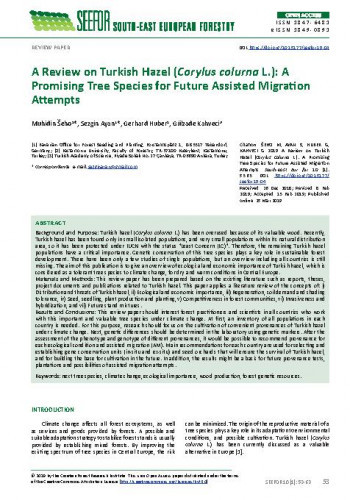Background and Purpose: Turkish hazel (Corylus colurna L.) has been overused because of its valuable wood. Recently, Turkish hazel has been found only in small isolated populations, and very small populations within its natural distribution area, so it has been protected under IUCN with the status "Least Concern (LC)". Therefore, the remaining Turkish hazel populations have a critical importance. Genetic conservation of this tree species plays a key role in sustainable forest development. There have been only a few studies of single populations, but an overview including all countries is still missing. The aim of this publication is to give an overview of ecological and economic importance of Turkish hazel, which is considered as a tolerant tree species to climate change, for dry and warm conditions in Central Europe. Materials and Methods: This review paper has been prepared based on the existing literature such as reports, theses, project documents and publications related to Turkish hazel. This paper applies a literature review of the concepts of: i) Distribution and threats of Turkish hazel, ii) Ecological and economic importance, iii) Regeneration, soil demand and shading tolerance, iv) Seed, seedling, plant production and planting, v) Competitiveness in forest communities, vi) Invasiveness and hybridization, and vii) Future stand mixtures. Results and Conclusions: This review paper should interest forest practitioners and scientists in all countries who work with this important and valuable tree species under climate change. At first, an inventory of all populations in each country is needed. For this purpose, research should focus on the cultivation of convenient provenances of Turkish hazel under climate change. Next, genetic differences should be determined in the laboratory using genetic markers.
Sažetak

 South-east European forestry : SEEFOR : international scientific journal in field of forestry : 10,1(2019) / editor-in-chief Dijana Vuletić.
South-east European forestry : SEEFOR : international scientific journal in field of forestry : 10,1(2019) / editor-in-chief Dijana Vuletić.